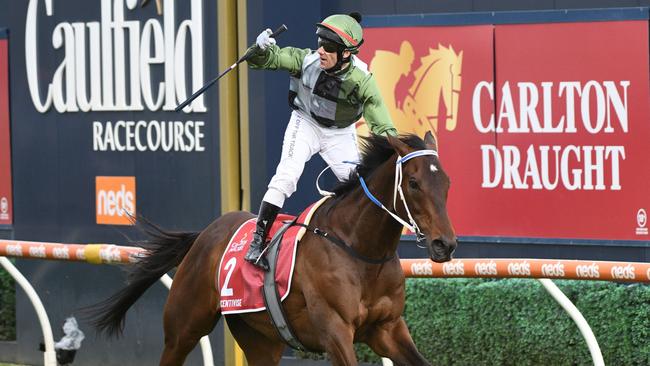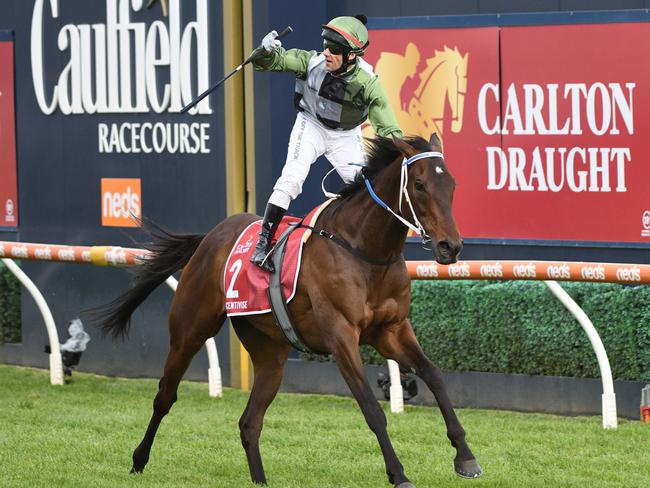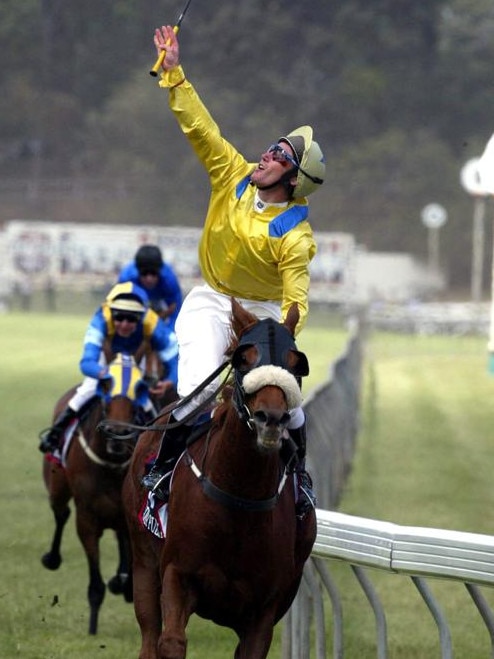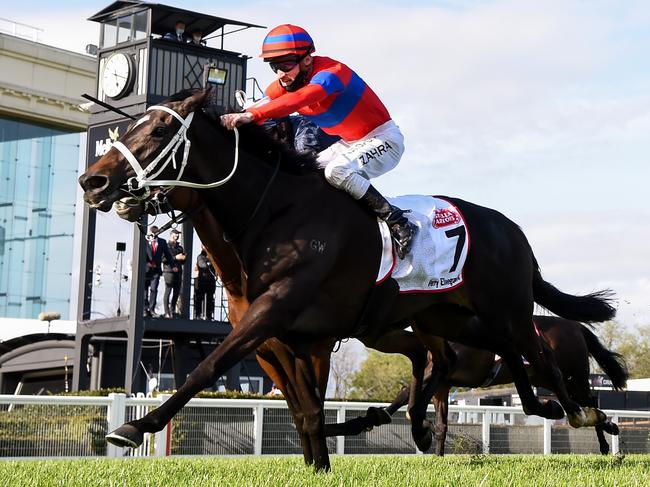Andrew Rule: Can Incentivise be the local hero for the people’s Cup?
Can a gangly horse born so knock kneed that pins were inserted into one leg be the hero to unite a distracted and divided public on Melbourne Cup day?

News
Don't miss out on the headlines from News. Followed categories will be added to My News.
We’re back!
Flemington re-opens to 10,000 hardcore racegoers on Tuesday in time to see if the best runner from Queensland since Cathy Freeman can reclaim our greatest race for the Australian heartland.
His name is Incentivise, “Splinter” to his mates, and proof that great horses make good names.
This is the skinny, gangly animal who humiliated the Caulfield Cup field with the sort of extravagant run that only champions can get away with, swooping around the mob like a kelpie heading sheep, the way Winx used to.
This is the horse born so knock kneed that pins were inserted into one leg to straighten it.
This is the horse who was such a picky eater he was four before he was strong enough to show a glimmer of the potential hidden inside that gawky frame.
This is the horse who started out by running a dozen lengths behind the winner in humble maidens until the day the penny dropped a few months ago and he started winning by the same outrageous margins.
This is the horse who won four races straight for his owner-breeder-trainer Steve Tregea before the money men from Melbourne made an offer he couldn’t refuse for just half of him.
Since then “Splinter” has won another five races, three of them Group 1s, under Peter Moody, the former Queenslander who made his name training the world’s greatest undefeated sprinter Black Caviar to 25 straight wins.

Tuesday’s Melbourne Cup might be the last time Incentivise ever runs in a handicap for fear of having to “carry the grandstand”, as the saying goes.
It’s good for racing, if not for his rivals, that the handicapper didn’t weight him out of the race, because the Cup needs a reason for an increasingly distracted and divided public to love it the way it used to be.
The race that used to stop a nation has never stopped the world because, Ireland apart, the world doesn’t care for racing as much as Australians and Kiwis traditionally have.
But the 10,000 people who get to Flemington on Tuesday will provide atmosphere for a broadcast audience of millions that can reasonably expect to see one of the most memorable Melbourne Cups in years.
There are honourable exceptions to every sweeping statement, of course. In 2002, the Irish wizard Dermot Weld returned to Australia with a big chestnut horse called Media Puzzle.
After winning the Geelong Cup with ease, Media Puzzle seemed likely to repeat Weld’s success with Vintage Crop, who became the first truly international Melbourne Cup winner in 1993.
The occasional imported horse had won before, trained by a local trainer, but Weld was a raider in the way that Kiwis always had been.
Media Puzzle was to be ridden by Damien Oliver but the week before the Cup, his brother Jason died after a track fall in Perth.

Their father Ray had also been killed in a race fall when Damien was three. So when he insisted on riding Media Puzzle, wearing Jason’s breeches in tribute, the win was what one observer called a victory “by Hollywood out of Sentiment”.
As a touching story it seemed hard to top, but the win of Michelle Payne on 100-1 outsider Prince Of Penzance in 2015 came close. Both victories prompted films. Media Puzzle and Ollie made the superior combination on the track but the Payne film was better. Both prove that a memorable story outstays a mere performance.
Piping Lane wouldn’t get within 100 metres of imported gallopers like Spanish Mission, but when he and John Letts won the Cup in 1972, it struck a chord. He was owned by Tasmanian farmer Ray Trinder, who rode his own horses in Tasmania as an amateur.
Trinder trained horses in Tassie but sent Piping Lane to the cagey George Hanlon to set for the Cup and the rest is history. After the race, Trinder and his wife were seen standing in the street outside the course lugging a cardboard box, trying to hail a taxi. In the box was the Melbourne Cup trophy.
In 1983 another farmer-horseman, Snowy Lupton, arrived from New Zealand with a rangy chestnut horse named Kiwi, who’d been educated rounding up cattle on his property at Waverley.
A cheeky kid named Jimmy Cassidy steered Kiwi from the back of the field, pumping with characteristic vigour as the big horse swept home to nail an electrifying win.
In 2001, Sheila Laxon trained Ethereal to win the Cups double, only the 11th horse in history to do it.
If Incentivise wins on Tuesday, he will be the 12th and the first in 20 years to nail the big double. Odds makers and odds takers say he can do it, with the resurgent Brett Prebble riding in what might be the greatest comeback in Australian racing in decades.

This year’s field is not the strongest, experts say. It doesn’t seem to have great depth once you get past Incentivise, Chris Waller’s temperamental star Verry Elleegant, and the well-supported import Spanish Mission.
The authorities are understandably, and belatedly, gun shy about letting imports race if there is a shadow of doubt about their soundness. This is because horses raised and trained in Britain and Ireland have suffered a string of breakdowns in the Cup or while preparing for it here.
One Irish trainer, labelled the best in the world, has had the misfortune to do more damage to the image of the Melbourne Cup in particular, and racing in general, than if someone had bombed the new Flemington grandstand.
Remove his horses from Cup runners of the last few years and the race’s safety record compares pretty well with the tiny casualty rate in flat racing generally. This must pain racing bodies that have spent eye-watering amounts attracting international entries in the interests of turning what was a hugely popular event, much like the AFL Grand Final, into a “world staying championship.”
Verry Elleegant, of course, was foaled in New Zealand but in the jet age that qualifies her as an honorary Aussie. Australians have been quick to adopt racehorses, not to mention actors and singers, from across the Tasman ever since Phar Lap’s day.
Verry Elleegant’s back story is as unconventional as the spelling of her name. Her sire, Zed, stands on a former Taranaki cattle farm, Glenwilliam Stud, owned by the Corcoran family.

Zed is about as well bred as an Australasian horse can be, but he started life standing at $1000 per service because his racing career was cut short before he could prove himself.
Zed’s opportunities were so limited they sent him to the isolated Erewhon station in the mountains, where he fathered foals from draught horse mares to be used as jumpers and stock horses. He got a reprieve and returned to Glenwilliam Stud after some of his early thoroughbred offspring started to win races.
Verry Elleegant is the standout of Zed’s progeny. She has won more and better Group races than anything in the Cup, but her temperament doesn’t match her ability. If she feels like rising to her best on Tuesday, she will give Incentivise and Spanish Mission and any surprise contenders something to beat.
There are, of course, another 20 runners that could “do a Prince Of Penzance” if something goes amiss with the favourites. One of them is Sir Lucan, an Irish four-year-old carrying only 50kg, and full brother of the ill-fated Sir Dragonet, who was put down after injuring himself in slow track work.
Horses aged four and five have by far the best strike rate in the Cup, although that did not stop last year’s winner Twilight Payment getting up as an eight year old – and going around again this week at nine. Let’s hope the rain has softened the track enough that his joints don’t feel the jar.
Omen bettors might like the idea that a horse called Lord Lucan raced in Victoria with success a few years ago.
The horse, possibly named after the fugitive lord who vanished from London after murdering his children’s nanny in the 1970s, was a proven Cup winner. That is, he won the Mt Wycheproof Cup of 2009.





